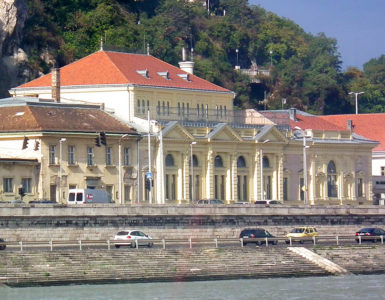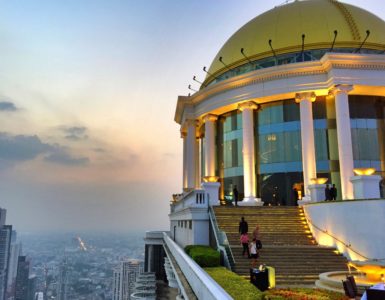For me, our day in Getxo and Bilbao is the most magical of our 2014 European cruise.
The ship docks in Getxo (say “GAT-cho”), where huge stone mansions line the waterfront. There are walls or gates around them, no security posts, no loops of razor wire, no mounted cameras. Our (excellent) guide, Mikel, points this out with pride. “No worries about things like that here.”
The little port city of Getxo is full of other surprises, too, including a unique way of crossing the river that splits the town in half: a suspended ferry that, instead of plowing across the water, moves through the air, dangling from a near-century-old network of cables.
All day long, it slides silently back and forth, carrying passengers, bicyclists, and even cars from one riverbank to the other.
From Getxo, Mikel drives us along winding roads through green fields to Bilbao. We make one stop along the way: a magnificent and haunted-looking little castle.
Because it’s privately owned and closed to the public, we can’t get inside, but we can enjoy the grounds (which are studded with everything from palms to evergreens to magnolias — trees from every country the garden’s designer visited during his lifetime).
If this place were located anywhere else, tourists would be hanging all over it. But because it is not well-known, we are virtually the only ones on the grounds. As we leave, we pause at the little sign explaining the castle’s history. It explains many helpful things about the time when the castle was built, including the fact that the people there “slept naked (to help prevent the spread of vermin and lice) as many as eight to a bed (for warmth).”
“It’s also for sale,” Mikel notes. “Just a few million Euro.”
But then: we are in Bilbao. Mikel tells us this part of the Basque region gets more than two hundred days of rain per year, but we cannot believe him. The sun is out, and the entire town is drenched in Technicolor greens, reds, purples, and blues.
Bilbao has accented its medieval roots with a high-tech future, producing a vibrant, sparkling, accessible present-day city center. Silent electric trams whisk people from place to place; curved paths, raised catwalks, and easy steps make walking a pleasure.
Happy people stroll the green parks and the winding pedestrianized streets of the old town, indulging in Bilbao’s unique passtime: the purusit of the perfect pintxo (say “pinch-cho”).
In the U.S. – in Midtown Atlanta, let’s say – you can easily get tapas (or “small plates”). If you walk into a restaurant or bar, they are likely to have tapas (or to call their appetizers tapas). These will likely be eight or nine dollars per plate. Have three, plus a glass of wine each, and you’ll likely spend almost forty bucks in one spot.
Here’s how that works in Bilbao: you enter a local pub, and the day’s offering of pintxos are on display. In the first spot we visit, the star of the show is the garlic butter toast, topped with Iberian air-cured ham and tomatoes:
Other candidates here include a folded Spanish omelette on thick slices of fresh bread, skewers of fried shrimp and cucumber balanced atop a pedestal of pumpernickel, and rafts of wheat bread slathered with melty cheese and spicy chorizo. You “pinch” at these, taking what you want: hence the name, “pintxos.”
No one monitors you. No one writes down what you take. It’s all on the honor system; at the end of the feast, you just tell the bartender what you’ve eaten, and he tallies it up.
To wash this all down, you can ask for wine or beer – but instead of serving you a full (and expensive) glass of either, the bartender will give you a three- or four-ounce pour of a delicious local beverage. In addition to being cheaper, these little drinks make it possible to sample several wines or several local beers without spending a fortune … or drinking too much.
The best surprise of all: the bill. For two delicious pintxos and a local beverage, we pay just under five dollars.
And this is how you spend the day: strolling from bar to bar, pinching at the pintxos and enjoying local wines and beers, with the occasional stop at the markets (where local delicacies are on sale for ridiculously low prices) or the beautiful little shops along the way.
When we can pinch no more, we waddle to the Guggenheim Museum and immerse ourselves in modern art:
Yoko Ono’s work is on display today, in an exhibit that includes everything from chessboards (with each side represented by pieces of the same color) to large canvas freight bags. Visitors are invited to crawl into the bags in pairs, seal themselves inside, remove their clothes, get dressed again, and re-emerge. On the day we were there, no one is taking Yoko up on the offer (though I can think of at least one friend in Atlanta who would have been all over this particular opportunity).
There are other works on display as well:
I’m a little sad when the day in Bilbao comes to a close. I feel very much at home in this city, even though I’ve ever been here before. Something about the way the river and the old town and the city center all fit together just works, and I find myself wishing I had days here instead of hours. As we drive away, I spy several shops I’d like to visit … and a restaurant I’d love to try … and a long shopping street we somehow missed. We vow to come back. (And we do!)
Before we go back to the boat, Mikel drives us to the opposite side of the pier. “Tourists coming off the boats almost always go to the right,” Mikel explains, gesturing at the strip mall bristling with cheap souvenirs and a McDonald’s. We go left, though, to a set of steps cut into the hill where, years ago, fishermen hauled their catches up into Gatxo to sell them.
Now, this is the site of hidden warren of shops and eateries with whitewashed walls and blue trim. In the sunlight, the greenery positively glows:
We make ourselves at home in a shady spot, enjoying a last reasonably-sized beverage and the final pinxos of the day. Sitting there with Clyde beside me, feeling the breeze from the ocean and the sunlight on my skin, I’m just about as happy as I’ve ever been.
There is no doubt in my mind: we are coming back to Bilbao, and bringing friends. (And we did!)
***
Special thanks to Mikel Gomez Urkijo of Tours by Basques, who provides private, premium tours in the Basque Country. He whisked us from point to point, but we never felt rushed or hurried. Mikel is laid back, easy-going, easy to talk to, and shares his local knowledge (and Basque history and even the region’s unique politics) in a way that makes learning about a new place feel like chatting with an old friend.
We paid Mikel out of our own pockets, and we didn’t accept any discounts or free services in return for this endorsement of his work. He’s the real deal, so I’m happy to help others discover him, his services, and his hometown.
Do yourself a favor and make sure your first day in the Basque country is spent with Mikel. Contact him at www.toursbybasques.com or tbb@toursbybasques.com.












Add comment